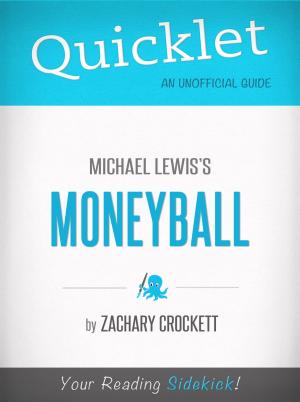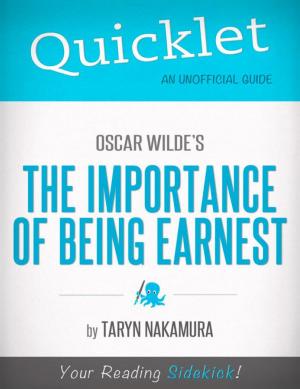Quicklet on Homer's Odyssey (CliffsNotes-like Book Summary)
Nonfiction, Reference & Language, Study Aids, Book Notes, Fiction & Literature, Literary Theory & Criticism| Author: | Kent McGroarty | ISBN: | 9781614648864 |
| Publisher: | Hyperink | Publication: | February 29, 2012 |
| Imprint: | Hyperink | Language: | English |
| Author: | Kent McGroarty |
| ISBN: | 9781614648864 |
| Publisher: | Hyperink |
| Publication: | February 29, 2012 |
| Imprint: | Hyperink |
| Language: | English |
ABOUT THE BOOK
The story of Odysseus in Homer’s Odyssey is the quintessential story of the hero. The struggles that plague Odysseus are symbols for the sufferings all humans encounter and endure. Odysseus’ encounters with gods and monsters reinforce the idea that facing challenges is part of the human condition. His psychological and physical battles illuminate the necessity to rise above things such as greed, fear, temptation, and selfishness to focus on what is really important: the love of family.
Like Odysseus, humans are at their best when we are able to stay strong in times of crisis, resisting the urge to give in to darker thoughts or feelings. Even today, the values upheld in the Odyssey serve as a beacon for those struggling to face life’s challenges.
MEET THE AUTHOR
Kent Page McGroarty is a freelance writer. She is a frequent lifestyle contributor to online magazine EDGE Publications and Demand Media sites LIVESTRONG.com, eHow Home and Garden and Local.com. She has a B.A. in English from Saint Joseph's University.
EXCERPT FROM THE BOOK
In addition to leaving behind wife Penelope, Odysseus has missed the childhood of his son, Telemachus, who was a baby when his father left for war. In the first book, Odysseus’s palace has been overrun by suitors who wish to marry Penelope and subsequently rule his kingdom of Ithaca. The now-grown Telemachus desperately wants to get rid of the suitors who eat Penelope’s food, drink her wine, and continually pester her to pick one of them, as they believe Odysseus to be deader than dead.
Luckily for Odysseus, his wife is about as clever as he is, and finds ways to avoid their “affections.” She remains faithful to Odysseus, though one of the suitors, Antinous, plans to murder Telemachus, whom he views as his only threat to the throne of Ithaca. Greek goddess Athena, disguised as old family friend Mentes, descends upon Ithaca to inform Telemachus that his father is still alive. Odysseus is imprisoned on an island with Calypso, a beautiful nymph in love with the hero. The goddess prepares Telemachus for a quest to find his father, as Odysseus no longer has a ship or crew with which to leave Calypso’s island.
Telemachus sets out to look for Odysseus, and through his visits with Greek kings Nestor and Menelaus the reader learns more about Odysseus’s journey. Odysseus himself also tells of his adventures after washing up on the shores of Phoenicians after the messenger god Hermes, sent by Zeus, convinces Calypso to free Odysseus. He is found by the beautiful princess of the Phoenicians and partakes of great hospitality from her parents, the king and queen of the Phoenicians...
Buy a copy to keep reading!
ABOUT THE BOOK
The story of Odysseus in Homer’s Odyssey is the quintessential story of the hero. The struggles that plague Odysseus are symbols for the sufferings all humans encounter and endure. Odysseus’ encounters with gods and monsters reinforce the idea that facing challenges is part of the human condition. His psychological and physical battles illuminate the necessity to rise above things such as greed, fear, temptation, and selfishness to focus on what is really important: the love of family.
Like Odysseus, humans are at their best when we are able to stay strong in times of crisis, resisting the urge to give in to darker thoughts or feelings. Even today, the values upheld in the Odyssey serve as a beacon for those struggling to face life’s challenges.
MEET THE AUTHOR
Kent Page McGroarty is a freelance writer. She is a frequent lifestyle contributor to online magazine EDGE Publications and Demand Media sites LIVESTRONG.com, eHow Home and Garden and Local.com. She has a B.A. in English from Saint Joseph's University.
EXCERPT FROM THE BOOK
In addition to leaving behind wife Penelope, Odysseus has missed the childhood of his son, Telemachus, who was a baby when his father left for war. In the first book, Odysseus’s palace has been overrun by suitors who wish to marry Penelope and subsequently rule his kingdom of Ithaca. The now-grown Telemachus desperately wants to get rid of the suitors who eat Penelope’s food, drink her wine, and continually pester her to pick one of them, as they believe Odysseus to be deader than dead.
Luckily for Odysseus, his wife is about as clever as he is, and finds ways to avoid their “affections.” She remains faithful to Odysseus, though one of the suitors, Antinous, plans to murder Telemachus, whom he views as his only threat to the throne of Ithaca. Greek goddess Athena, disguised as old family friend Mentes, descends upon Ithaca to inform Telemachus that his father is still alive. Odysseus is imprisoned on an island with Calypso, a beautiful nymph in love with the hero. The goddess prepares Telemachus for a quest to find his father, as Odysseus no longer has a ship or crew with which to leave Calypso’s island.
Telemachus sets out to look for Odysseus, and through his visits with Greek kings Nestor and Menelaus the reader learns more about Odysseus’s journey. Odysseus himself also tells of his adventures after washing up on the shores of Phoenicians after the messenger god Hermes, sent by Zeus, convinces Calypso to free Odysseus. He is found by the beautiful princess of the Phoenicians and partakes of great hospitality from her parents, the king and queen of the Phoenicians...
Buy a copy to keep reading!















